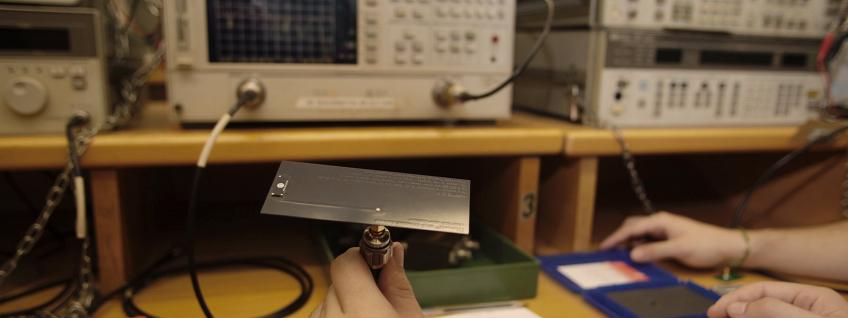This laboratory gives a wide and current view of the communication systems contributing with the necessary means to accomplish the objectives of teaching, researching and technology transference. The available space to work in this laboratory is of 40m2.
Digital Modulation
The communications tendency since a while is digital; by this means it is necessary to know the modulation techniques used to transmit his kind of information. We have a digital RF generator, a RF channel simulator, a vectorial analyzer, software for modulation analysis (Agilent VSA) and other auxiliary elements.
Mobile Communications
The mobile communications system have become very essential, the telephony service GSM-3G and the wireless phone system DECT are two clearly examples. Knowing these systems is essential for an Engineer in Communication Systems. In this case we have a GSM, PCS, DCS-1800 and a DECT analyzer.
Antennas
Antennas are used in every radio communication system. For this reason it is very useful to be familiar with them and know how to measure their parameters. This measurement system is composed by a network analyzer, fastening support and different antennas.
Circuits and Microwave systems
Most of the present radio links, whether anagogical or digital, work with microwaves. And besides the saturation of the lower part of the radioelectric spectrum, the work frequency of the new communication systems are higher each time. In this practice, the different elements that compose a microwave radio link will be studied. The instruments for this case are: a network analyzer (20GHz), noise measurement system, RF generator up to 20GHz and other auxiliary elements.
Optoelectronics
Now-a-days the most important transmission is the optical fiber. It is used in voice transmissions, in local areas networks, in geographic networks, etc. In these practices the different elements used for the information diffusion by an optical fiber network and for verifying the correct work of this kind of networks are studied. The most used instrument is the optical reflectometer, with an optical spectrum analyzer. In this laboratory are also studied the different kinds of optical transmitters and receivers.
Simulators and Circuits Implementation
Due to the difficulty that the design of radiofrequency circuits and microwaves imply, simulators are very important when building this kind of circuits. It is very interesting that students know how to use them. This laboratory has a radiofrequency circuit and microwave ADS (advanced Design System) simulator.
Study of Radio Trensceivers
It is the study and measurement of the principal characteristics of radiofrequency transmitter and receivers, such as sensibility, selectivity, spurious emissions, etc. The transmitters and receivers are tested following the ETSI standards. Besides, some problems found in the RF communication systems and their possible solutions are part of the study. The equipment is formed by RF generators, an audio analyzer, an RF spectrum analyzer, a transceiver and auxiliary tools.
Telephony Systems
It is an introduction to the different kinds and services of telephony networks. We have a 2 PBX that allow a beginning to the principal characteristics of telephony, analyzing the signalization and different services and functions.
